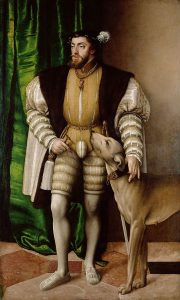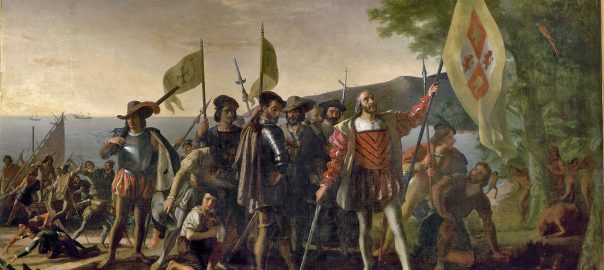For these daily/yearly posts, I’ve been relying on English Wikipedia’s annual listings, supplemented by various timelines (of the Ming Empire, the Mughal Empire, the Portuguese Empire, etc.) Today’s pickings, relating to 1528 CE, have been pretty thin. So after giving a few bullet-points I shall look a little more broadly at the whole phenomenon of the Spanish conquistadores whose plunderous and genocidal exploits were the main driving force of European-origined world domination in this period.
By the way, the painting above is the painting of Columbus and his crew making their first landfall in the Americas in 1492. It was painted by Architect of the US Capitol John Vanderlyn some time in the early 19th century CE and hangs in the US Capitol.
First, though, a quick step back to 1527, when England’s Henry VIII made his first appeal to Pope Clement for the annulment of his marriage to Catherine of Aragon (who was a daughter of Ferdinand and Isabella.) I’d failed to list that yesterday. But that whole story would develop a lot later, paving the way for England’s entry into the world-domination stakes…
Okay, so 1528:
- Lots of Spanish expeditions going on– and sometimes they even intersected and complicated each other’s plans. In the southeast portion of South America, an expedition led by Diego García de Moguer intersected on the Paraná River with one led by Sebastian Cabot (sailing for Spain) and they had quite a falling-out.
- Also, conquistador Álvar Núñez Cabeza de Vaca and his companions become the first known Europeans to set foot on the shores of what is present-day Texas. Francisco de Montejo attempted an invasion of the Yucatán, but was driven out by the Maya peoples.
- Spain did however take direct control of Acapulco
- Meantime, in Henan province, China, during the mid-Ming dynasty, a vast drought deprived the region of harvests for the next two years, killing off half the people in some communities.
More about Spain’s conquistadores
The first half of the 16th century CE saw a huge explosion of world-conquering activity under the command of the Spanish Crown.

In 1516 CE, the 16-year-old Charles V ascended to the throne of Spain. Here are some relevant facts about him from WP:
Charles was born in the County of Flanders to Philip the Handsome of the Austrian House of Habsburg (son of Maximilian I, Holy Roman Emperor, and Mary of Burgundy) and Joanna the Mad of the Spanish House of Trastámara (daughter of Isabella I of Castile and Ferdinand II of Aragon). The ultimate heir of his four grandparents, he inherited all of his family dominions at a young age, due to the premature death of his father and the mental illness of his mother. After the death of Philip in 1506, he inherited the Burgundian Netherlands, originally held by his paternal grandmother Mary.[2] In 1516, he became co-monarch of Spain with his mother Joanna, and as such he was the first king of Spain to inherit the country as dynastically unified by the Catholic Monarchs, his maternal grandparents.[3] The Spanish possessions at his accession also included the Castilian West Indies and the Aragonese Kingdoms of Naples, Sicily and Sardinia. At the death of his paternal grandfather Maximilian in 1519, he inherited Austria and was elected to succeed him as Holy Roman Emperor. He adopted the Imperial name of Charles V as his main title, and styled himself as a new Charlemagne.[4]
Charles V revitalized the medieval concept of the universal monarchy and spent most of his life defending the integrity of the Holy Roman Empire from the Protestant Reformation, the expansion of the Ottoman Empire, and a series of wars with France.[5] With no fixed capital city, he made 40 journeys, travelling from country to country; he spent a quarter of his reign on the road.[6] The imperial wars were fought by German Landsknechte, Spanish tercios, Burgundian knights, and Italian condottieri. Charles V borrowed money from German and Italian bankers and, in order to repay such loans, he relied on the proto-capitalist economy of the Low Countries and on the flows of gold and especially silver from South America to Spain, which caused widespread inflation. He ratified the Spanish conquest of the Aztec and Inca empires by the Spanish Conquistadores Hernán Cortés and Francisco Pizarro, as well as the establishment of Klein-Venedig by the German Welser family in search of the legendary El Dorado. In order to consolidate power in his early reign, Charles suppressed two Spanish insurrections (Comuneros’ Revolt and Brotherhoods’ Revolt) and two German rebellions (Knights’ Revolt and Great Peasants’ Revolt).
In other words, though I’ve been referring to him here mainly as the King of Spain, he held numerous other titles and controlled massive stretches of European territory way beyond today’s Spain and entertained the aspiration of leading a “Universal Monarchy”– for which aspiration, presumably, the Catholic church would be one vehicle.
The English WP page about the Conquistadores tell us this:
The Age of Exploration was hallmarked in 1519, shortly after Europe’s discovery of the America’s, when Fernando Cortés begins his expedition on the Aztecan Empire.[5] As the Spaniards, motivated by gold, slaves, fame, and Christianization, established relations and war with the Aztecs, the slow progression of conquest, erection of towns, and cultural dominance over the natives brought more Spanish troops and support to modern day Mexico. As trading route over the seas were established by the works of Columbus, Magellan, and Elcano, land support system was established as the trails of Cortés’ conquest to the capital.
Human infections gained worldwide transmission vectors for the first time: from Africa and Eurasia to the Americas and vice versa.[6][7][8] The spread of old-world diseases, including smallpox, flu and typhus, led to the deaths of many indigenous inhabitants of the New World.
In the 16th century perhaps 240,000 Spaniards entered American ports.[9][10] By the late 16th century gold and silver imports from America provided one-fifth of Spain’s total budget.[11]
And later on, this:
The conquistadors were professional warriors, using Old World tactics, short-swords, and cavalry. A few also had crude firearms known as Arquebus. Their units (compañia) would often specialize in forms of combat that required long periods of training that were too costly for informal groups. Their armies were mostly composed of Spanish, as well as soldiers from other parts of Europe and Africa.
Native allied troops were largely infantry equipped with armament and armour that varied geographically. Some groups consisted of young men without military experience, Catholic clergy who helped with administrative duties, and soldiers with military training. These native forces often included African slaves and Native Americans. They not only fought in the battlefield but served as interpreters, informants, servants, teachers, physicians, and scribes…
Castilian law prohibited foreigners and non-Catholics from settling in the New World. However, not all conquistadors were Castilian. Many foreigners Hispanicised their names and/or converted to Catholicism to serve the Castilian Crown. For example, Ioánnis Fokás (known as Juan de Fuca) was a Castilian of Greek origin who discovered the strait that bears his name between Vancouver Island and Washington state in 1592. German-born Nikolaus Federmann, Hispanicised as Nicolás de Federmán, was a conquistador in Venezuela and Colombia. The Venetian Sebastiano Caboto was Sebastián Caboto, Georg von Speyer Hispanicised as Jorge de la Espira, Eusebio Francesco Chini Hispanicised as Eusebio Kino, Wenceslaus Linck was Wenceslao Linck, Ferdinand Konščak, was Fernando Consag, Amerigo Vespucci was Américo Vespucio, and the Portuguese Aleixo Garcia was known as Alejo García in the Castilian army…
Castilian law banned Spanish women from travelling to America unless they were married and accompanied by a husband. Women who travelled thus include María de Escobar, María Estrada, Marina Vélez de Ortega, Marina de la Caballería, Francisca de Valenzuela, Catalina de Salazar. Some conquistadors married Native American women or had illegitimate children.
This latter claim seemed rather under-stated, since lower down we’re told that, “Francisco Pizarro had children with more than 40 women.”
Also– and no surprise here– “The division of the booty produced bloody conflicts [among the conquistadores].”
… The above excerpts come from only a couple of the early, introductory portions of that English-WP page, the rest of which provides a lot more– apparently well documented– detail. The page includes Portuguese global expeditions, as well as Spanish.
